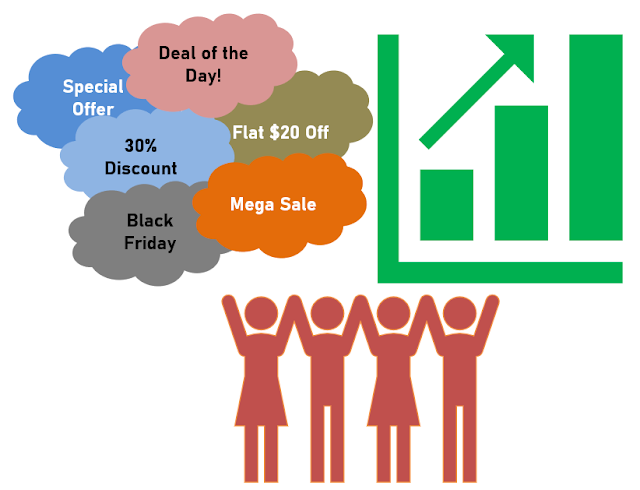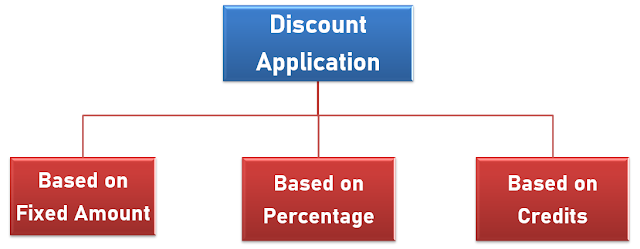Importance of Discounting in SaaS Billing
Discounting in SaaS Billing
Everyone is fond of discounts! Come any special day, such as Black Friday, we see long queues in front of retail stores and heavy traffic on E-commerce sites.
Discounts and promotions play a vital role in business growth, as they promote customer acquisition, retention, and increased revenue growth from long-term subscribers.
 |
| Discounts and Promotions |
In this article, we will discuss the importance of discounting in SaaS Billing.
SaaS providers can improve customer acquisition and customer retention by leveraging the benefits of discounts and promotions.
In addition to B2C and Retail segments, discounting plays a key role in Enterprise and B2B segments by encouraging potential clients to spend more by incentivizing a high number of purchases, etc. Enterprise customers often demand personalized services or offerings and accordingly, a discounting mechanism should be tailored to their needs; due to its flexibility, custom pricing for enterprises can be achieved through discounting.
A discount is a charge type in the product catalog through which service providers offer price reductions to customers on different types of charges such as subscription fees, usage fees, one-time fees, account level charges, etc. Discounts are mainly defined by Product owners, Sales, and Marketing teams to attract new customer segments, retain the existing customer base, and improve customer loyalty.
 |
| Types of Discount Applications |
Based on a fixed amount: This provides the flexibility to apply a fixed amount of discount. (Example – Purchase an item equivalent to $500 or more and get a flat $50 discount.)
Based on a percentage: It allows applying a percentage-based discount on the charge amount. (Example – Subscribe to the Platinum plan and get a 5% discount on the monthly bills.)
Based on credits: In this mechanism, discounting can be applied in terms of promotional credits or non-currency resources. (Example – Subscribe to the Air mile plan and accumulate 300 extra air miles on each flight journey.)
Account level discount: This type of discount is applied to the overall account level charges irrespective of the number of subscriptions attached to the account (such as granting a 10% flat discount to all the branches of a manufacturing firm on purchases of raw materials).
Cycle or Recurring discount: This is applied to grant a recurring discount on cycle-based charges (such as granting a flat $10 rebate on monthly license fees for the next 6 months).
One-time discount: This is applied to one-time charges like activation fees, device fees, etc. (such as on purchase of a Pay TV subscription, there is a 100% discount on Set-Top box and installation fees).
Real-time or usage discount: This is applied based on the usage consumption of a specific service (such as consume service usage of $100 and you get a discount of $5 on the final bill).
Billing time discount: This is a conditional discount that is applied during the bill run. It is based on the aggregated bill amount or the period of subscription. Such as –
- If aggregated bill charges cross $500, apply a billing time discount of 5%.
- If a customer has subscribed to a service for more than 1 year, then apply a fixed amount discount from the 13th month onwards.
Bundle discount: This type of discount is applied when combinations of services or products are purchased together (such as a discounted rate for comprehensive health check-up packages).
Volume discount: The more you purchase or consume, the more you receive the volume discount. It is offered to amplify the sales revenue or service consumption (such as providing a volume discount to an enterprise customer for a multi-year contract or subscribing to the yearly plan of a Magazine, you get an additional 3 months free).
Promotional discount: This kind of discount is offered as a part of a campaign for a limited duration (such as when a new software upgrade version is released, and it is offered for the first 15 days at a discounted price per license).
Group discount: This kind of discount is also known as Parent level or Company level discount. In this mechanism, a group discount is applied to the collective purchases/consumption of the group which comprises of Parent and several Child accounts (or, subsidiaries). Discounting benefits are enjoyed by all the members of the group (such as when a large enterprise has availed group discount for buying manufacturing raw materials for its 10 subsidiaries and includes purchases from vendors as well).
As understood from the above, the discounting feature is quite flexible and can be molded to cater to the different needs of businesses and targeted customers.
 |
| Click to enlarge - Discounting at various Subscription Lifecycle Stages |
Customer Acquisition: Promotional discounts, Freemiums or Free trials play a significant role in acquiring new customers. Freemium or free trials allow businesses to showcase their offerings to potential customers without burdening them with any upfront commitments. As customers experience the benefits, the likelihood that they will subscribe to paid or upgraded plans increases.
Similarly, promotional discounts offered during acquisition campaigns help to achieve more sign-ups and conversion to high-value plans.
Discount offerings during acquisition help to achieve the conversion of leads or prospects to paid customers.
Post-Acquisition: Once customers are acquired, they can be motivated to increase high usage or consumption through volume, usage, or billing time discounts. They can also be offered a one-time discount during activation or installation of services. During onboarding, customers opting for maximum contract durations can be rewarded with bundle discounts or recurring discounts.
Continue...
To read the complete article, please visit the website Synthesis Systems. Here, I have written this original article.
--------------
Glossary: SaaS (Software-as-a-Service), B2C (Business to Consumer), B2B (Business to Business)
Please use the CONTACT Form to get in touch with me for any training needs, consulting assignments, or other requirements. You can also connect with me via LinkedIn.










Post a Comment